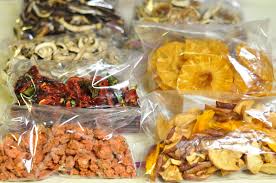It’s Harvest Time!
It is that time of year in here in Western PA where you start gathering things from your garden. If you have been successful with your garden sometimes it can be overwhelming with the amount you have produced. The question now is what do I do with all this food? What is the best way to store or preserve it so it can be used throughout the year? There is no reason you should let all that hard work go to waste! Although there are several excellent ways to preserve food, this article will focus on Dehydration or Food Drying.
Food Drying:
How to dry your own fruits, vegetables and other foods:
Dehydration or food drying is an alternative method to canning and freezing fruits and vegetables. If you have a surplus of fruits or vegetables from your garden, but lack the canning equipment or freezer space, drying may be the right method for you! Dehydrated foods have a number of advantages: Dehydration is a low-cost way to preserve food and is free from concerns of botulism, the dried foods require less storage space than canned goods, and there’s no freezer to keep running.
Food Drying Principles
Dehydrating your own produce does require time and some knowledge of food drying principles.
Preparation:
- Select the best fruit and vegetables! As with canning and freezing, dehydrated foods are only as good as the fresh fruit or vegetables. When selecting fruits and vegetables for dehydration, choose ones that are ripe, unbruised and at peak-eating quality.
- Prepare foods to be dehydrated as you want them to be served. Apples, for example, may be sliced, cut into rings, or pureed for fruit leather.
- Keep pieces uniform in size and thickness for even drying. Slices cut 1/8 to 1/4-inch in thickness will dry more quickly than thicker pieces.
- Foods should be washed before drying. Wash foods to remove any dirt, or insects before drying. Items such as herbs should also be rinsed well, lightly shake off the excess water before dehydration.
- To prevent browning: try steaming, sulfuring or coating light-colored fruits and vegetables with acids such as lemon juice or ascorbic acid (sodium bisulfite) before drying. Steaming or blanching also is recommended for vegetables to inactivate enzymes that cause vegetables to mature, or toughen.
During Drying.
- Select the food drying method and equipment that is right for you. Foods can be dried in a conventional oven, a commercial dehydrator, or in the sun. Drying times vary with the method and foods chosen. Be sure to read the instructions with your dehydrator.
- Maintain 130°F to 140°F with circulating air: Remove enough moisture as quickly as possible to prevent spoilage. A drying temperature of 130° F to 140° F allows moisture to be removed quickly without adversely affecting food’s texture, color, flavor and nutritive value. If the initial temperature is lower, or air circulation is insufficient, foods may undergo undesirable microbiological changes before drying adequately. If the temperature is higher, or humidity too low, nutrients can be lost or moisture may be removed too quickly from the product’s outer surface. This causes the outer surface to harden and prevents moisture in the inner tissues from escaping. When testing for sufficient dryness, cool foods before testing.
- Know when your food is dry: Some foods are more pliable when cool than warm. Foods should be pliable and leathery, or hard and brittle when sufficiently dried. Some vegetables actually shatter if hit with a hammer. At this stage, they should contain about 10 percent moisture. Because they are so dry, vegetables do not need conditioning like fruits.
After Drying (for fruit only)
- Allow dried FRUIT (not vegetables) time to “condition”: When dry, allow fruit to “condition” for four to 10 days before packaging for storage. The moisture content of home dried fruit should be about 20 percent. When the fruit is taken from the dehydrator, the remaining moisture may not be distributed equally among the pieces because of their size or their location in the dehydrator. Conditioning is the process used to equalize the moisture. It reduces the risk of mold growth.
- To condition the fruit, take the dried fruit that has cooled and pack it loosely in plastic or glass jars.
- Seal the containers and let them stand for 7 to 10 days. The excess moisture in some pieces will be absorbed by the drier pieces.
- Shake the jars daily to separate the pieces and check the moisture condensation. If condensation develops in the jar, return the fruit to the dehydrator for more drying.
- After conditioning, package and store the fruit as described below.
Packaging the dried foods
- Seal the dried food: Dried foods are susceptible to insect contamination and reabsorption of moisture and must be properly packaged and stored immediately. First, cool completely. Warm food causes sweating which could provide enough moisture for mold to grow. Package dehydrated foods in tightly sealed containers, such as moisture-proof freezer containers or Mylar Food Bags, or dark scalded (sanitized) glass jars.
- Choose the right containers: Glass jars, metal cans or boxes with tight fitted lids or moisture-vapor resistant freezer cartons make good containers for storing dried foods. Heavy-duty plastic bags are acceptable, but keep in mind that they are not insect and rodent proof. Plastic bags with a 3/8-inch seal are best to keep out moisture.
- Fruit that has been sulfured should not touch metal. Place the fruit in a plastic bag before storing it in a metal can. Sulfur fumes will react with the metal and cause color changes in the fruit.
- Pack as tightly as possible without crushing.
- Pack food in amounts that will be used in a recipe. Every time a package is re-opened, the food is exposed to air and moisture that will lower the quality of the food.
Storing the dried foods


- Store in a cool, dark, dry place. Food quality is affected by heat. The storage temperature helps determine the length of storage; the higher the temperature, the shorter the storage time. Most dried fruits can be stored for 1 year at 60°F, 6 months at 80°F. Vegetables have about half the shelf-life of fruits.
- Use foods within six to 12 months for best quality.
- Check dried foods frequently during storage to see if they are still dry. Foods that are packaged seemingly “bone dry” can spoil if moisture is reabsorbed during storage. Glass containers are excellent for storage because any moisture that collects on the inside can be seen easily Foods affected by moisture, but not spoiled, should be used immediately or re-dried and repackaged. Moldy foods should be discarded.
Selecting your Dehydrator:
There are a variety of Dehydrators available on the market today. When you decide to purchase a dehydrator select one with a thermostat and a fan. This will ensure you have the proper drying temperature and constant air flow resulting in even results. Dehydrators without a fan will require constant rotation of the trays resulting in longer drying times. This is because you must open the dehydrator during the drying process causing heat loss. Dehydrators without fans lack the air flow which will result in uneven drying. Some items will dry faster than the others depending on the location in the dehydrator. At Chef’s Kitchen we take pride in our top quality Excalibur Dehydrators. The Excalibur Dehydrators are designed to produce excellent food drying results. They offer both temperature control as well as circulation fans that will result in even and efficient drying. Many of the Excalibur Dehydrators are also equipped with timers so you can dehydrate your food without constant supervision. Sure there are dehydrators that are less expensive but be aware that they do not offer the circulation fan, temperature control or timers that the Excalibur Dehydrators offer. The Excalibur Dehydrators are designed for excellent results, will last for years and they also look great in any kitchen. Not only can you dehydrate fruits and vegetables with your dehydrator, they are also great for other things as well. You can easily make fruit leathers and jerky. The Excalibur Dehydrators are excellent for drying meats you can even use it for various craft projects. Visit Chef’s Kitchen to find dehydrating accessories that will make your drying efforts a success.




Comments are closed.